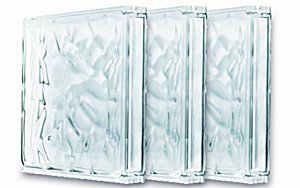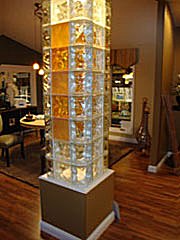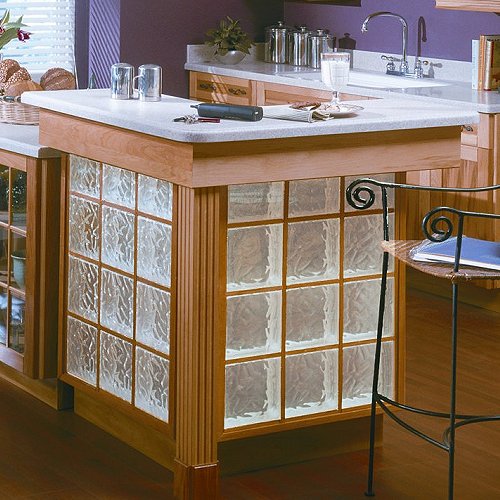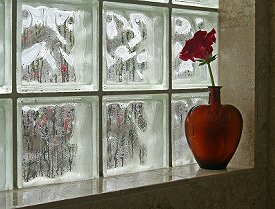Acrylic And Glass Block
Although acrylic and glass block are officially classified as "building materials", they're much cooler than that. They're pretty versatile because you can use them in a variety of ways to make your home more beautiful and functional.
Acrylic block and glass block are both similar and different. You could think of them as cousins in the same sort of 'building material' family. They serve the same purpose but do it in different ways by giving their users (that's you) more flexibility in using them. If you're totally confused at this point, read on to get a closer look at how acrylic and glass block can enhance your home.
What You Should Know About Acrylic & Glass Block
The first thing you should probably know, if you haven't already figured it out (and it's ok if you haven't), is that these building blocks are made from two different materials. Each material has it's distinct advantages and disadvantages, as well as design applications where one might be a better choice than the other.
That's why it's helpful to understand how acrylic and glass block are both alike and different so that you can made the right choice.
Glass block is obviously made from glass and is available in clear or tinted styles. You can buy it in a variety of textures such as a wavy or pebbled surface finish.
Glass block weighs about 6 times as much as an equivalently-sized acrylic block. An 8-inch square acrylic block weighs about a pound whereas the same size glass block weighs in at about 6 pounds.
This heft makes it a good solid building material but impractical for operable (opening) windows. Consider what it would take to open a window that's made with about 16 large glass blocks weighing in at over 100 pounds.
The advantages of glass block include its durability and hardness. It's harder than acrylic and won't scratch as easily. And being glass, it's won't degrade over time or discolor.
On the flip side, its main disadvantage is its weight. Using glass block in movable windows isn't practical because it would make the window too heavy, both for the framing and the poor soul trying to open and close it. Walls and shower partitions made from stacked glass block also add up to a lot of weight. You'll need to make sure the framing in your floor is sufficient to carry the load.
Acrylic block (sometimes referred to as "acrylic glass block") is a thermoplastic material. It looks very similar to glass block and like glass is available in a variety of surface textures and color tints.
The primary advantage of acrylic block is its light weight, compared to glass block. Because its much lighter it can be used in operable privacy windows. In other words, you can have your privacy window and open it too. That's always a benefit, particularly in bathrooms, where there are times when you just want to let in some fresh air. You also don't have to worry that your floor can carry the weight of an acrylic block partition or shower wall like you do with glass block.
 Photo Courtesy Of Hy-Lite-A US Block Windows Co.
Photo Courtesy Of Hy-Lite-A US Block Windows Co.
Another desirable feature of acrylic block is that it affords faster assembly of structures like partitions and shower enclosures. Solid glass block was traditionally mortared in place which takes time and skill. Similar architectural features can be done faster and without the motar and grout approach usually taken with glass block.
Disadvantages of acrylic block include the fact that it's softer than glass and more prone to scratching. The use of abrasive cleaners and scouring pads should not be used on acrylic block because of the tendency to scratch and dull the surface. If you do scratch acrylic it's not the end of the world however. There are products like Novus Plastic Polish that are made to remove scratches from plastic.
One final point about acrylic is that over time, plastics naturally react with exposure to ultraviolet light and have a tendency to "yellow". Makers of acrylic block typically imbue their products with technologies that minimize this effect, including that the material passes standards such as the ASTM (American Society for Testing & Materials) standard for UV stability.
If you're interested in acrylic block check the literature to see what measures the maker has taken to reduce this characteristic. Some manufacturers tout the fact that their products surpass industry standards and that any discoloration over time is imperceptible to the human eye.
How You Can Use It In Your Home
Given the versatility of acrylic and glass block the limits of it uses are really only bounded by your imagination. There's also nothing standing in your way if you want to use both types of acrylic and glass block to use them in situations that take advantage of their inherent advantages. For example you might want a real glass block shower enclosure while also using acrylic block in an opening privacy window.
Here are a few ideas on how you can put acrylic and glass block to work in your house:- Windows (fixed and operable)
Using acrylic and glass block in windows is a tried-and-true way of using this versatile building material. The offer great privacy while allowing the light to shine through, making them a perfect choice in windows above or adjacent to showers, spa tubs and other privacy areas.Photo Courtesy Of Hy-Lite-A US Block Windows Company
Acrylic block windows have the advantage of being operable, allowing you to open them. Casement (hinged at the side and opening outward like a door) or awning windows (hinged at the top) are two examples of acrylic block operable windows. The benefit with this type of window is that it allows you to bring in some fresh air when you want to while still being able to close them for the privacy you want. This obviously isn't possible with fixed block windows.
- Walls & Partitions
Walls are another application of transparent block material. Glass block has been used on large expanses of exterior walls, essentially making the wall a large translucent window. This type of design requires that you consider the structural as well as efficiency implications. However if you're building a new home or adding on, a glass block wall is a unique design application, particularly for a modern style.Interior walls partitions are two other applications for acrylic or glass block. Walls don't necessarily have to join another wall -- you could use glass or acrylic block for a partial-width wall to close down a large opening between two rooms. Partitions and half-high walls are often used in bathrooms to separate the toilet from the rest of the bathroom and glass or acrylic offers a way of getting this privacy while avoiding a closed-in feel that might occur with opaque materials.
- Shower Enclosures
Acrylic and glass block are a good choice for shower enclosures because of the combination of privacy and light that these materials offer. They work well regardless of whether it's a full shower enclosure with a door or a partition for a door-less walk-in shower. You can even vary the amount of privacy by the texture of glass you choose. - Privacy Deck Wall
If you have a nice outdoor deck but don't want the neighbors checking out every one of your social gatherings think about using acrylic or glass block as a form of privacy fence. You can use it in combination with wood and intersperse translucent panels along the fence. It'll give you the privacy without feeling like you're hemmed in and inside a room (which negates the purpose of an outdoor space anyway). - Kitchen Islands & Bars
The top of your kitchen island or basement bar might be some other material but that doesn't mean what supports it can't have some style. Glass block is one alternative to use as the base of an island and offers a unique style option compared to more traditional wood cabinet bars and islands. Throw in some colored glass block or some lighting for added effect too. - Door & Window Transoms and Sidelights
Window and door transoms are another good application for acrylic and glass block Using thicker acrylic or glass above doors and windows provides light but can also cut down on glare which can sometimes be an issue with transom windows that catch the sunlight at high angles.Sidelight windows, those narrow panels on either side of an exterior door also afford a good spot for block windows since the translucency provides light but offers privacy and security.
- Clerestory Windows
Clerestory windows are typically installed high on a wall, higher than normal sight lines. They offer good daylighting while keeping the inside space private. However anyone from a higher vantage point (like a 2nd story home next door or a higher home on a crowded Seattle or San Francisco hillside) can still peer in. That's where an acrylic or glass block clerestory window comes in handy. Once again, it allows for natural light while the amount of seclusion you want. - Interior Windows (Between Rooms)
Sometimes one room gets enough light while an adjacent room doesn't. You can use acrylic or glass block to form 'windows' in the wall. Not only do they make an interesting style statement but they're practical too since they can help channel some of the light into the room that needs a bit more natural light. Photo Courtesy Of Hy-Lite-A US Block Windows Company
Photo Courtesy Of Hy-Lite-A US Block Windows CompanyThese kinds of "windows" need to be installed during framing (new build or during a remodel) or else you'll need to tear out some of the existing drywall and frame in the windows. Just be sure you're don't tear out a load bearing wall. Talk to an architect or contractor if you're not sure.
- Interior Columns
Ever think of using glass or acrylic for an interior column? Most columns are
traditionally made from wood, stone or drywall. Using acrylic or glass block puts a new twist on the concept of the interior column. Photo Courtesy Of Columbus Glass Block
Photo Courtesy Of Columbus Glass Block
Keep in mind that if you use it on a real structural column there will need to be a structural member in the center of the column, but that doesn't mean you can't wrap that member in glass block.
- Doors & Shutters
Acrylic block can be used in both doors and window shutters. Acrylic block door inserts are available for retrofit into existing doors. Kits are available that include a framed acrylic block panel that's inserted into a door that's had the center panel cut out.Acrylic block window shutters are an alternative to an opening acrylic block window. The shutters are closed when you need privacy and can be opened when you want a clear view outside the window.
 Photo Courtesy Of Columbus Glass Block
Photo Courtesy Of Columbus Glass Block
 Photo Courtesy Of Hy-Lite-A US Block Windows Company
Photo Courtesy Of Hy-Lite-A US Block Windows Company
 Photo Courtesy Of Hy-Lite-A US Block Windows Company
Photo Courtesy Of Hy-Lite-A US Block Windows Company
The point here is that there are virtually limitless applications for acrylic and glass block. You're only limited by your imagination, save for any structural implications that you might have to deal with depending on how you want to use this versatile building product.
Features & Other Points To Consider Before You Buy
Features & Innovations To Be Aware Of
Acrylic and glass block are more than just glass or plastic building materials. Many of these products are actually "systems" that use other parts and materials to bring them together to make the various walls, windows and other forms that were discussed above.Some of these products have special features that make them more DIY-friendly and/or less complex and time consuming to build. In other words, not all acrylic and glass block 'systems' are the same. Here are some key features to look for when considering acrylic or glass block windows and building materials:
- Pre-Fab Kits or Individual Blocks
In the old days you were stuck with using individual glass blocks and sticking them together with mortar, like traditional brick construction. Today you can still take that route or buy pre-fab kits for windows and walls that do away with the mortar. The choice is yours. Companies like AcrylicBlocks4Less offer pre-made block windows and Glass Block Innovations makes a unique alternative to the traditional mortar and grout system with real glass block by instead using a PVC joint system.There are even shower kits for making a glass block walk-in or standard shower. Pittsburgh Corning's Shower Systems provide an acrylic shower base that accommodates and supports the glass block walls. You can use a traditional mortar or use Pittsburgh Corning's ProVantage® system for a mortar-less assembly.
- Pre-Made Standard Size Windows
Basement windows are another good application for acrylic and glass block. Some companies stock pre-made basement, bathroom and garage windows in common sizes. Instead of having to assemble the blocks to make the window you just install the block window into the wall opening in similar fashion to a standard window. You can do it yourself or hire a contractor to do it for you. Products like the CrystaLok™ window system uses real glass block in a PVC frame. The glass block is thinner, which makes for a lighter window and easier installation. - Better Material Performance
Some acrylic and glass blocks are made to perform better with regard to energy efficiency. Blocks with a Low-E coating are more efficient than glass or acrylic blocks that have no treatment. If you intend on getting a block window, look for products with either the ENERGY STAR rating or products that have Low-E coatings. - Window Vents
If you like the idea of a stationary glass block window but are concerned about ventilation there are companies that sell block windows with opening vents. You can also buy the vents separately to install in non-preassembled block windows.
Some Final Considerations
Finally, given all the information about how you can use acrylic and glass block in your home and what features to look for, ponder these final considerations to help you make sure whether or not this kind of building material fits in your design scheme:- How To Choose Between Acrylic And Glass Block
Choosing between acrylic or glass block first depends on the specific function you want these materials to perform. Operable windows usually means acrylic block. Structural implications are another consideration for things like walls and partitions.Once these scenarios are considered it comes down to finding the products that meet your needs from an aesthetic, cost and ease of construction point of view. You may prefer the look of one material over the other or, you might base your decision on the ease of assembly that one material or block 'system' offers.
- Variable Privacy
The type of texture or pattern you choose on acrylic or glass block will help determine the degree of privacy provided. Usually the more texture the acrylic or glass surface has the more privacy you'll get since the image behind it is more obscured.Another point to keep in mind is the light/dark difference. Even though acrylic and glass block provide a measure of privacy, the degree of privacy is reduced somewhat when a lighted room is viewed from a dark outside environment. In other words, it's easier to see that someone or something is behind the window in these situations. If you have a glass block exterior window in your
shower, you may want a texture that provides enough privacy for nighttime situations. Photo Courtesy Of Columbus Glass Block
Photo Courtesy Of Columbus Glass Block - Mix In Some Color And Variable-Size Block
A lot of the acrylic and glass block windows and walls that you see in pictures and advertisements tend to be all clear glass. While that's ok, there's a lot of style options that await you if you consider popping in some colored blocks for visual contrast.This master bath suite shown at the right with glass provided by Columbus Glass Block shows how color can add a tremendous amount of visual appeal. In addition to the colored blocks are blocks of varying size.
The combination of these two design elements add visual interest and detail. The same concept can be achieved with anything made from acrylic and glass block, whether it's a shower enclosure or a window.
Where To Get Glass & Acrylic Block
Acrylic and glass block is a fairly common building material and locating it shouldn't be a problem. Before you buy however your best option is to first spend some time getting familiar with the various types of glass and acrylic products and "systems" that are available. From there it's easier to decide whether you can buy locally or you'll need to order materials from a national manufacturer/distributor.
These materials are sold both locally and nationally. Depending on where you live you may have a local supplier for acrylic or glass block. You can search online using the appropriate keyword (for example "acrylic block" or "glass block") and your city, town or zip code. Otherwise there are companies and distributors that sell these products nationally and can ship them to you.

One final consideration before deciding where to buy is whether you're going to do the work yourself or hire out the work. The benefit of buying local, particularly from businesses that specialize in the installation of acrylic and glass block is simply that -- they have experience working with the product.
On the other hand if you have some DIY skills there are many acrylic and glass block products that are designed to be DIY-friendly, especially the pre-fabricated products like the acrylic shower walls and enclosures. Don't overlook the possibility of doing the work yourself if you have the time, the right tools and feel confident you can get the right guidance from whomever you buy your products.
Here's More Related Info That Might Be Helpful...
Bath Design Ideas - What better place to put acrylic and glass block to work than the bathroom. Discover a multitude of ideas, some "must haves" and some "discretionary" for a great bathroom.
